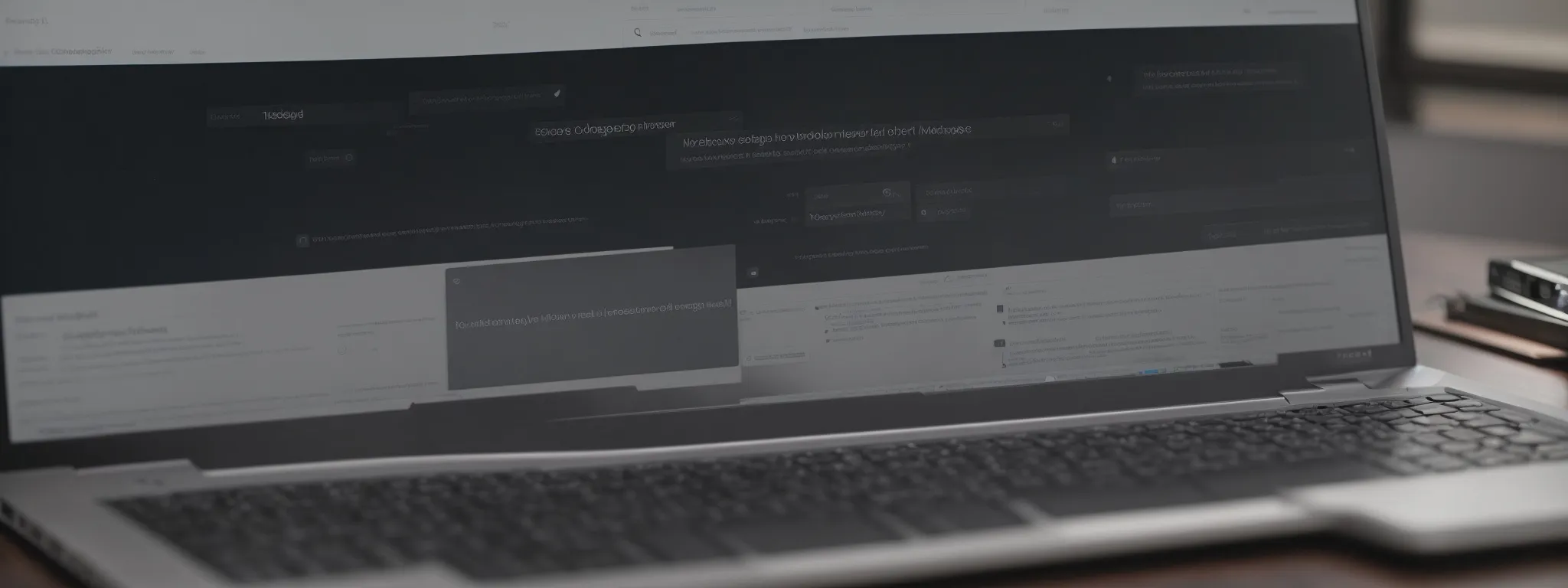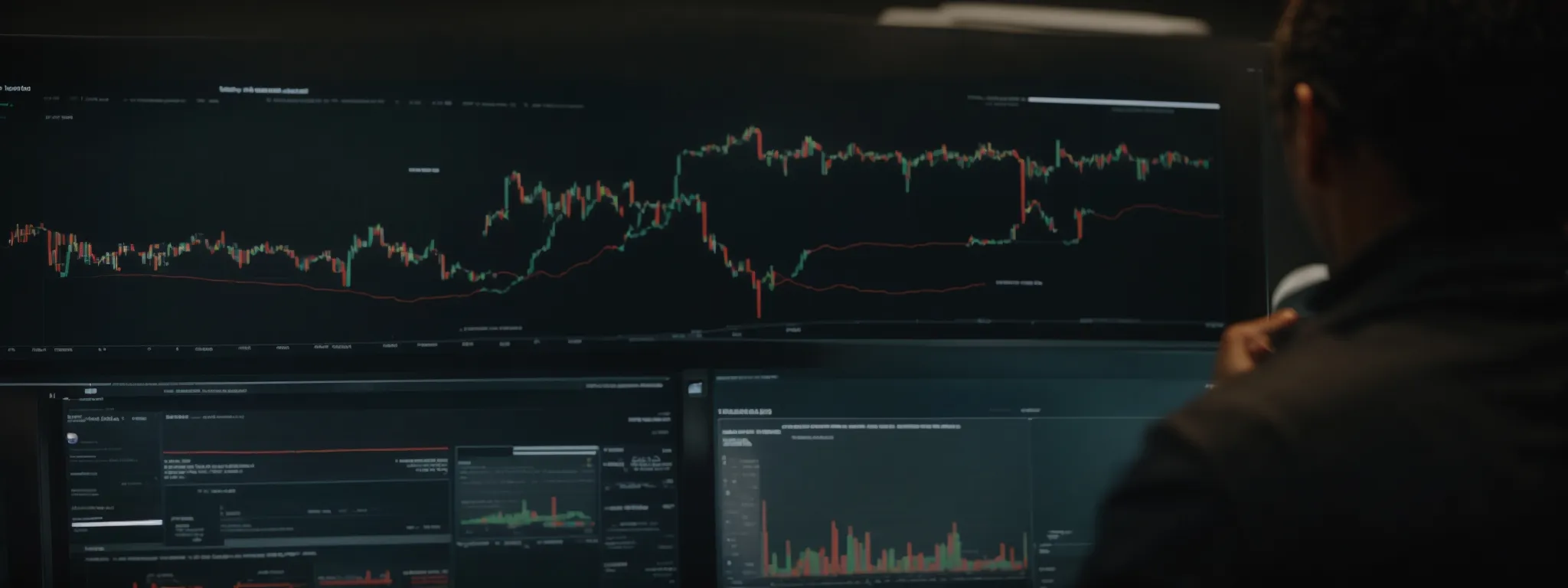How Does Paid Search Work?
Unlocking the Mechanics of Paid Search Advertising In the dynamic landscape of digital marketing, the mastery of Paid Search Advertising stands as a pivotal force driving online […]
Unlocking the Mechanics of Paid Search Advertising
In the dynamic landscape of digital marketing, the mastery of Paid Search Advertising stands as a pivotal force driving online business success.
Through meticulous crafting of paid ads and strategic auction-based bidding, companies sky-rocket their visibility in search engine results, connecting with their target audience at the zenith of their search queries.
Embracing the intricacies of ad placement and budgeting is the backbone of a proficient search campaign, poised to amplify company’s brand presence and optimize their return on investment.
Keep reading to navigate the rich tapestry of Paid Search Advertising, from setting the stage to fine-tuning for peak performance.
Key Takeaways
- Paid Search Advertising Is a Strategic Approach Where Visibility in Search Engine Results Is Achieved Through Carefully Crafted Paid Ads
- LinkGraph Provides Expert SEO Services, Utilizing the Search Atlas SEO Tool to Optimize Campaigns by Aligning Ad Groups, Keywords, and Target Audiences
- Quality Score Is a Fundamental Metric in Paid Search Campaigns That Dictates Ad Rank and Cost-Efficiency
- Meticulous Keyword Selection and Campaign Adjustments Based on Performance Data Are Crucial for Successful Paid Search Campaigns
- LinkGraph’s Approach Emphasizes Continuous Improvement Through Ad Customization, Strategic Use of Ad Extensions, and Rigorous Testing and Iteration
Introduction to Paid Search Advertising

In the dynamic sphere of digital marketing, Paid Search Advertising emerges as a pivotal component, epitomizing the intersection of user intent and targeted advertising.
By unraveling the concept of Paid Search, one explores a marketing strategy where companies vie for prominence in search engine results through paid ads.
Such visibility is not merely about securing a spot at the top of the list but is tailored to the search terms potential customers use.
Platforms for Paid Search Ads, ranging from Google Search Network to Bing Ads, serve as battlegrounds where advertisers harness keywords and bid amounts to ensure their offerings resonate with their target audience.
This introduction aims to dissect the functionalities of Paid Search and position it within the broader context of digital marketing, laying a foundation for enterprises to comprehend its significance and potential applications.
Defining the Concept of Paid Search
At the core of Paid Search lies the model where firms engage in an auction-based system, purchasing ad placements that align with specific keyword phrases entered by users into search engines. It’s a precise science, navigating the realm of PPC (Pay-Per-Click) campaigns, where advertisers pay a fee each time their text ad is clicked, effectively buying visits to their site rather than attempting to earn those visits organically.
LinkGraph, as an adept in crafting and managing these sophisticated SEO campaigns, implements a blend of keyword research, strategic bidding, and compelling ad copy to optimize the performance of each campaign. They refine ad placements on the search result page, ensuring that each client’s product or service meets the searcher’s eye at a critical moment of their search query journey.
The Role of Paid Search in Digital Marketing
Paid Search Advertising occupies an integral role in Digital Marketing by facilitating a direct conduit to audiences actively seeking specific products or services. Through targeted ad campaigns, businesses achieve increased visibility within search engine result pages, enhancing the likelihood of attracting qualified traffic and elevating conversion rates.
The strategic placement and timing of paid ads act as crucial determinants in grabbing the attention of a target audience. These elements contribute to building brand awareness and can propel a brand into the coveted position of being top-of-mind for consumers when considering purchases:
- Strategic placement ensures ads appear in conjunction with relevant search queries.
- Sharp timing aligns ad visibility with the peak moments of consumer search activity.
- Brand awareness efforts transition potential customers from recognition to decision-making.
Understanding the Platforms for Paid Search Ads
Deciphering the intricacies of Paid Search Advertising platforms is akin to mastering the controls of a sophisticated flight deck. With LinkGraph’s SEO services, businesses navigate Google’s search platforms, Bing Ads, and other paid search landscapes with finesse, optimizing for factors such as ad rank, bid amount, and quality score to achieve the best possible ad placement.
Adept utilization of Search Atlas SEO tool by LinkGraph allows clients to harness the full potential of paid search platforms, aligning ad groups, keywords, and target audiences with precision. Each search campaign is fine-tuned, crafted to interact seamlessly with user search behaviors and the ebb and flow of web traffic, ensuring the ad spot resonates and captures attention within the search engine result pages.
Key Components of Paid Search Campaigns

Deconstructing the mechanics of Paid Search Advertising requires an understanding of its key components, which collectively determine the success of a campaign.
At the heart of this strategy is the ‘Quality Score,’ a critical metric that reflects the relevance and performance of PPC ads and keywords.
In adjoining territories of this digital expanse, various ad formats, each with distinct advantages, cater to the diverse needs of businesses and their advertising objectives.
Equally vital is the synergy between ad relevance and the quality of the landing page, a liaison that ensures a seamless and satisfying user experience, ultimately bolstering the potency of a campaign’s conversion potential.
These elements form the triad that guides advertisers in creating effective, impactful paid search strategies.
Deciphering the Term ‘Quality Score’
In the intricate ecosystem of Paid Search Advertising, ‘Quality Score’ serves as a barometer for the efficacy of ppc ads and their associated keywords. It is a composite metric devised by search platforms to assess the relevance and caliber of an advertiser’s paid search components.
LinkGraph’s SEO services place substantial emphasis on maximizing this Quality Score, recognizing its profound impact on ad rank and consequent cost per click (CPC). Mastery of this facet is pivotal; a higher Quality Score signifies more cost-effective ad placements and refined targeting, ultimately driving improved campaign performance and ROI.
Exploring Different Paid Search Ad Formats
The repertoire of Paid Search Ad Formats is diverse, each tailored to meet various advertising needs and objectives. Text ads, for instance, are a staple on search platforms, providing concise, clickable headlines and descriptions optimized for targeted keywords, while display ads infuse visual appeal to captivate prospects across websites and apps.
LinkGraph’s expertise extends to specialized formats such as Google Shopping Ads which exhibit product images, prices, and brand information directly within google search results, enabling e-commerce entities to spotlight their offerings at the pinnacle of consumer search intent.
Importance of Ad Relevance and Landing Page Quality
Ad relevance is the cornerstone of a successful paid search campaign, as it ensures the search ads presented align impeccably with the user’s search query. LinkGraph’s SEO Services meticulously tailor ad copy to resonate with the intended audience, fostering a connection between the user’s intent and the company’s message. This precise alignment is instrumental in elevating click-through rates and enhancing the overall efficacy of the campaign.
Concurrently, the quality of the landing page to which an ad directs users cannot be overstated. LinkGraph recognizes that the journey from ad click to customer action hinges on a landing page that delivers on the promise of the ad, marrying relevance with user experience. A well-constructed landing page not only nurtures consumer trust but also plays a pivotal role in increasing conversion rates, amplifying the return on investment in a paid search campaign.
Setting Up Effective Paid Search Ads

Initializing a successful Paid Search Advertising campaign involves meticulous planning and a strategic approach to ad creation.
Mastering the art of crafting compelling ad copy is pivotal, as it is the conduit through which businesses convey their value proposition to potential customers.
Furthermore, incorporating essential keywords optimizes the relevance and reach of the campaign, ensuring that the ads surface in front of audiences who are most likely to engage.
Lastly, optimizing ads for maximum visibility demands a fine-tuned understanding of ad platforms and user behavior, enabling businesses to stand out on the crowded digital stage of search engine result pages.
These preparatory steps form the bedrock upon which high-performing Paid Search campaigns are built.
Crafting Compelling Ad Copy
Crafting compelling ad copy demands an artful blend of persuasive language and targeted messaging that speaks directly to the heart of the consumer’s search needs. LinkGraph’s team wields this art with precision, weaving keywords with persuasive calls to action to capture the attention and interest of the target audience efficiently, thereby maximizing the impact of each search ad.
The efficacy of Paid Search Advertising pivots on the authority and allure exuded by the text ad. Professionals at LinkGraph sculpt ad copy to not only engage and attract but also to mirror the search term’s intent, ensuring that the message delivered is congruent with the user’s quest for information or services, effectively optimizing the campaign’s reach and resonance.
Incorporating Essential Keywords
Incorporating essential keywords is akin to charting a map for a treasure hunt – it is requisite for guiding the right audience to a company’s offerings. The judicious selection and incorporation of keywords influence the visibility of paid search ads in response to a user’s search query directly correlating to the relevance of the campaign to the end-user.
LinkGraph leverages the potency of Search Atlas, their sophisticated keyword tool, to distill an exhaustive list of target keyword phrases that align with the user’s search. Each keyword is a beacon, designed to connect the search engine user’s intent with the client’s paid search campaign, forming a bridge between query and conversion:
- Critical keyword identification establishes the foundation for ad relevance and search alignment.
- Strategic keyword deployment determines the touchpoints within the search engine result page.
- Continual keyword optimization ensures the evolution of the campaign alongside changing user search patterns.
With the support of LinkGraph’s SEO services, clients fortify their marketing strategy, bolstering their campaigns with keywords that are meticulously chosen and dynamically monitored for performance, steadily steering the campaign’s trajectory toward optimal engagement and superior results.
Optimizing Your Ads for Maximum Visibility
Optimizing ads for maximum visibility is a meticulous process, requiring a keen understanding of the advertising platform’s dynamics. The right mix of ad extensions, compelling call-to-action, and strategic maximization of ad placements propels the visibility of these paid search ads, ensuring that they grab the spotlight in a crowded digital marketplace.
The precision in ad targeting and timing acts as a linchpin in the art of paid search, allowing businesses to capture the attention of audiences at the zenith of their intent. Strong visibility in paid search campaigns translates into elevated click-through rates (CTR) and positions the brand at the forefront of consumer consideration:
- Ad extensions enrich the structural complexity of ads, providing users with additional context and pathways.
- A powerful call-to-action serves as the pivotal moment that transforms interest into action.
- Strategic ad placements are evaluated and adjusted in real time, adapting to the fluid landscape of user searches and competitor movements.
A Deep Dive Into Bidding and Budgeting

The architecture of Paid Search Advertising is founded upon a critical interplay between bidding strategies and budget allocation.
Effective management of these elements not only dictates the financial viability of a search campaign but also its potential to penetrate the marketplace and achieve tangible business goals.
It requires an understanding of the underlying auction process that controls ad placement, alongside the development of an ad budget that aligns with both company financial restraints and marketing aspirations.
Furthermore, expert bid management is necessary to navigate this competitive landscape, where each bid has the power to elevate a brand’s standing within the search engine results.
As these topics unfold, the focus will remain on empowering advertisers with the acumen to orchestrate their Paid Search endeavors towards utmost efficiency and impactful returns.
Understanding the Auction Process
Demystifying the auction process integral to Paid Search Advertising requires grasping its pay-per-click model—a dynamic and competitive bidding system. A company’s ad placement on search engine result pages hinges on this real-time auction, where bid amounts are placed for specific keywords with the intent to capture prime ad real estate.
Organizations strive for optimal ad visibility, and LinkGraph intricately manages the auction intricacies by balancing bid amounts against the expected return on investment. Discriminating ad spend from potential profit, they configure campaigns that fiercely compete for visibility while adhering to the client’s budgetary constraints.
Strategies for Setting Your Ad Budget
Formulating a robust ad budget strategy propels LinkGraph’s clients towards achieving their desired marketing objectives without compromising financial prudence. They underscore the significance of calibrating ad spend with anticipated outcomes, putting meticulous research into forecasting potential click volumes and conversion rates to ensure the investment aligns with projected returns.
LinkGraph’s approach to budget management in paid search encompasses the dynamic monitoring of campaign performance, coupled with strategic adjustments that optimize spend efficiency. This constant evaluation and refinement enable organizations to remain agile, responding to market shifts and maximizing the impact of every dollar invested in their advertising efforts.
Tips for Effective Bid Management
Effective bid management stands as the cornerstone of a prosperous paid search campaign, and LinkGraph firmly plants this principle within its strategic framework. Their team’s deft calibration of bid amounts hinges on real-time data analysis, ensuring their clients’ ads maintain competitive ad placement without exceeding budgetary limits.
Exploiting the nuances of ad auction algorithms requires a meticulous approach, and LinkGraph delivers by optimizing each bid for cost-efficiency and conversion potential. By continually assessing keyword performance and search trends, they dynamically adjust bids to articulate a brand’s presence precisely where it impacts most – at the confluence of user intent and ad visibility.
Measuring Success in Paid Search

In the realm of Paid Search Advertising, the evaluation of campaign success transcends mere execution, entrenching itself in the scrutiny of performance metrics and analytics.
Success in paid search is measured not just by visibility or ad placements but by concrete, data-driven outcomes that reflect the strategic objectives of the campaign.
Advertisers who excel in this domain understand that, while crafting and launching ads is crucial, the true mastery of Paid Search lies in their ability to track key metrics, interpret analytical insight, and recalibrate campaigns in response to performance data.
This analytical perspective enables marketers to pivot with precision, enhancing the efficacy of their paid search endeavors to drive better investment returns and cement stronger market positions.
Key Metrics to Track Campaign Performance
Discerning the success of any paid search endeavor necessitates a keen focus on key performance metrics, which serve as a barometer for the efficacy of the marketing strategy employed. Conversion rate stands as a critical metric, gauging the percentage of visitors that take a desired action, be it a purchase or form submission, thus providing tangible evidence of a campaign’s ability to turn prospects into valuable customers for LinkGraph’s clients.
Another vital metric integral to determining the performance of a paid search campaign is the click-through rate (CTR), which measures the frequency at which ads are clicked in relation to the number of times they are shown. CTR offers insight into the relevance and appeal of the ads and, when analyzed by LinkGraph, aids in refining targeting strategies to ensure that the ads resonate with the intended audience and drive engagement.
Utilizing Analytics Tools for Insight
To accurately assess the impact of Paid Search campaigns, LinkGraph employs sophisticated analytics tools that provide granular insights into user behavior and campaign performance. These tools distill complex data into actionable intelligence, enabling a deep understanding of both the consumer journey and the touchpoints that influence decision-making.
Analytics tools not only highlight the efficacy of individual ads or keywords, but they also detect patterns and trends that guide LinkGraph’s strategic adjustments. By aggregating and analyzing data, LinkGraph’s experts refine and evolve their SEO strategies, ensuring their clients’ Paid Search campaigns consistently yield optimal results.
Fine-Tuning Campaigns Based on Performance Data
Fine-tuning campaigns based on performance data is a critical step for LinkGraph in cementing the success of its clients’ Paid Search Advertising efforts. They utilize a data-driven approach, meticulously adjusting campaigns by analyzing key performance indicators, ensuring that each decision is informed and aligned with the overarching SEO strategy.
LinkGraph’s iterative process empowers continuous campaign improvement, leveraging real-time data to navigate the complexities of search engine marketing. Through the adept modification of ad copy, keyword selection, and budget allocations, their clients experience tailored campaign adjustments that respond deftly to the ever-changing landscape of search behaviors and market trends.

In the intricate dance of Paid Search Advertising, understanding the calculation of ad rankings is tantamount to orchestrating a successful bid for online visibility.
Search engines employ a strategic blend, weighing an advertiser’s bid against the Quality Score of their ad to determine its position on the search engine result page.
LinkGraph excels in this area, navigating the delicate balance between expenditure and ad optimization to boost their clients’ rankings.
Embarking on a quest to enhance a campaign’s Quality Score entails a deep dive into the relevancy of ad copy, the user experience on landing pages, and the click-through rates—all contributing to a performance symphony where every note is critical.
How Ad Rankings Are Determined by Search Engines
In the competitive arena of search engine marketing, ad rankings emerge as a decisive factor shaped by the intricacies of search platforms’ algorithms. These ad rankings are primarily a function of the advertiser’s bid amount in conjunction with the Quality Score of the ads, a measure encompassing click-through rates, relevance, and the user experience provided by landing pages.
LinkGraph, leveraging its comprehensive grasp of SEO nuances, optimizes clients’ ad positions by refining Quality Scores and adjusting bids. Such meticulous adjustments enable the fusion of cost-effective ad spend with prime digital real estate, reinforcing the prominence of a brand’s presence within the search engine result pages.
The Interplay Between Bids and Quality Score
The equilibrium between bid amounts and Quality Score is instrumental in Paid Search Advertising, as it dictates cost-efficiency and ad effectiveness. Advertisers must strike a balance: bid aggressively enough to secure visibility, yet wisely to ensure the capital invested yields a significant return on ad placement.
LinkGraph employs a strategic methodology to enhance Quality Score, thereby enabling favorable ad positioning despite potentially lower bids. This optimization focuses on three key factors: the relevance of ad copy, the user experience of the landing page, and the historical click-through rate of the ad itself:
| Quality Score Factor | Significance in Ad Ranking | Optimization Strategy |
|---|---|---|
| Ad Copy Relevance | Pivotal in matching user search intent | Tailoring language and keywords to user queries |
| Landing Page Quality | Essential for user experience and conversion potential | Ensuring content aligns with ad promises and is user-friendly |
| Click-Through Rate (CTR) | Reflects ad resonance with target audience | Continual testing and refinements of ad elements |
Steps to Improve Your Ad’s Quality Score
Enhancing an ad’s Quality Score necessitates a concerted effort focused on amplifying the ad’s relevance to user search intent. LinkGraph’s professionals adeptly refine ad content and keyword alignment, ensuring that each ad not only meets the search criteria but exceeds it, thus lifting the Quality Score and fostering more competitive ad rankings.
Consideration of the user’s experience on landing pages is also a significant factor in nurturing a Quality Score. LinkGraph’s expertise extends to optimizing the user interface and the content’s pertinence, delivering a cohesive experience that resonates with the audience, thereby potentially increasing both the Quality Score and the overall efficacy of the ad’s performance within the search platform.
Strategies for Enhancing Paid Search Performance

In today’s competitive digital marketplace, leveraging Paid Search Advertising with finesse can break the barriers between potential customers and a company’s offerings.
As brands seek to optimize their search ads for maximum impact, the emphasis shifts to advanced strategies that amplify ad effectiveness.
Core among these strategies are ad customizations to target the right audience, the judicious use of ad extensions to expand ad capabilities, and a commitment to testing and iterating ads to foster continual improvement.
This segment delves into these tactics, providing insights to master the craft of Paid Search Advertising and secure a company’s position in the frontlines of consumer visibility.
Targeting the Right Audience With Ad Customizations
LinkGraph meticulously harnesses ad customizations to home in on the nucleus of a company’s target audience, transforming generic messages into personalized narratives. These customizations ensure that every ad addresses the unique needs and behaviors of different audience segments, fostering deeper connections and encouraging more meaningful interactions.
Elevating campaign precision, LinkGraph’s tactics involve sculpting user-centric ad experiences, leveraging demographic data, and behavioral insights to refine targeting. This granular approach to ad customization not only heightens relevance but also drives up the efficacy of campaigns, resonating with consumers at a level that generic advertising cannot achieve.
Using Ad Extensions to Enhance Your Ads
Within the theater of Paid Search Advertising, utilizing ad extensions is tantamount to equipping one’s artillery with enhanced capabilities. LinkGraph capitalizes on this feature, meticulously integrating additional information such as contact details, additional links, and product reviews to enrich their client’s ads, providing a depth of information that facilitates user decision-making.
Ad extensions serve as a significant lever in capturing user interest and improving ad performance metrics. By expanding the real estate and prominence of an ad on the search result page, LinkGraph’s expert use of ad extensions actively increases the likelihood of clicks and conversions, offering the user a variety of pathways to interact with the company’s offerings.
Testing and Iterating for Continual Improvement
LinkGraph esteems the process of testing and iterating as a foundational pillar in the realm of Paid Search Advertising. Their client campaigns undergo continuous evaluations, with rigorous A/B testing protocols in place to inform the evolution and fine-tuning of each search ad, ensuring perpetual enhancement of ad efficiency and performance.
Engagement with data underpins every strategic move made by LinkGraph’s team, where iterative refinements are based on analytical evidence rather than conjecture. This approach ensures that each ad iteration is a step closer to paid search perfection, optimizing variables such as wording, design, and keyword usage for heightened user resonance and superior campaign results.
Conclusion
In conclusion, mastering the mechanics of Paid Search Advertising is essential for digital marketers looking to connect products and services with the right audiences effectively.
Companies like LinkGraph navigate the complexities of PPC campaigns using strategic keyword research, compelling ad copy, and quality score optimization to ensure ads not only reach the top of search results but also resonate with potential customers.
Through targeted strategies, ad customizations, and rigorous testing, they enhance ad relevance and user experience, which are paramount to campaign success.
By continuously fine-tuning these elements, businesses can leverage the power of paid search to gain visibility, improve click-through rates, and ultimately achieve a strong return on investment in the highly competitive digital marketplace.















































































